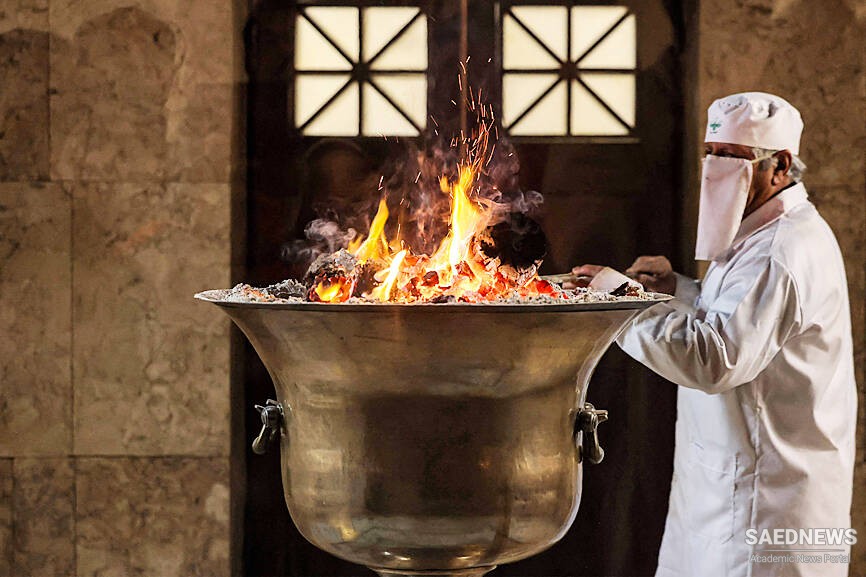The fire is kept burning day and night. It is tended regularly by priests in a ceremony known as boi. The fire room has no decorations. There are no statues and no pictures on the wall—nothing to detract from the beauty and power of the fire. In the rest of the fire temple are meeting rooms, lecture halls, and a library. These rooms, which have no sacred significance, may have portraits or plaques commemorating donors and paintings that represent the prophet Zarathustra. The entrances to the building are often decorated with flowers and beadwork, signifying that the building is a place of tranquility, purity, and happiness.
In an atash behram only fully initiated priests may enter the fire room. Properly initiated and ritually pure Zoroastrian worshippers may, if they wish, observe the rites through iron bars or grillwork that separate them from the sacred fire. An atash adaran also houses consecrated fire. It differs from an atash behram in the number of rituals performed in establishing the temple and the number and type of ceremonies a priest must perform before entering the fire room. The fire in an atash dadga is similar to a household fire. Although still worthy of reverence, it is not specially consecrated. In India this grade of temple is known as an agiary. In North America it is called a darbe mehr or dar-e meher. No high rituals are held there and there may be no full-time priest. If the fire is kept burning at all times it may be fed by a layperson who has bathed and put on clean clothes. Special ceremonies such as weddings, funerals, and initiations are performed by priests who come for the occasion. These too are always performed in the presence of fire.
Zoroastrianism has much in common with other world religions, several of which it influenced. Like religions such as Judaism, Christianity, and Islam it is monotheistic—that is, its followers believe in one supreme God. They believe in life after death and in heaven and hell. Zoroastrianism also has a strong code of ethics that its believers are expected to follow in their daily lives. Like Christianity, Islam, and Buddhism it had a specific founder who came to reform older religious practices. However it differs from other religions in significant ways. Unlike Islam it is not fatalistic. The evil in the world is not the will of God but exists because of flaws in the material world and within the human heart. Zoroastrians control their destiny after death by their actions on earth, their choice of good and truth over ignorance and evil.
Like Christians and Jews, Zoroastrians believe that a savior will come at the end of time to lead the faithful into a perfected world. However Zoroastrianism differs from Christianity, whose believers are saved by faith in Jesus Christ and by God’s grace rather than by their good works. Also, Zoroastrians do not believe in original sin. People are born pure but may be influenced by the evil around them. For Zoroastrians it is a lifetime of following the teachings of Zarathustra that brings about salvation, not faith alone. Zoroastrianism also differs from Hinduism in that there is no belief in reincarnation and no transmigration of the soul. People live on this earth but once and have only one chance to find their way to eternal peace.
Zoroastrianism holds a unique place in the history of religion. Its founder and prophet, Zarathustra, originated the concept of one great and supreme God. He proposed an explanation for the problem of evil in a world created by a good God through the notion of the twin mentalities, the Spirit of Truth and The Lie, which are present in the human heart, and through the imperfection in the material world. Zoroastrianism thus answers the question with which all religions must struggle: “How can a good and loving God permit evil and suffering in the world?” Zoroastrians believe that evil and suffering are the work of the Lie, Angra Mainyu, and not of Ahura Mazda, who battles evil and sin and will eventually defeat it.
Zarathustra also introduced the concept of an afterlife in which people would be welcomed into the glory of Ahura Mazda or dropped into the pit—representing hell—as a result of their actions on earth. In Angra Mainyu, Zoroastrianism gave the world the concept of Satan, the tempter and ruler of the underworld. Zarathustra spoke of a savior who would come to lead the righteous at the end of the world, and of a final judgment in which the existing world would be destroyed and a new, perfect world would come into being. He offered humankind free will with which to choose good over evil in order to perfect the world in a joint venture with Ahura Mazda. He changed the ancient Iranian polytheistic (the belief in more than one god) notion of religion as a way of attempting to calm angry gods to one of ethical actions on the part of humans. In the ancient Iranian society where women had lesser roles to play, he declared that they were religiously equal to men and also capable of salvation.
Zoroastrianism is believed to have influenced other world religions with which it came into contact. Some see Cyrus, the great king of Persia who liberated the Jews in 537 b.c.e. from their captivity in the ancient city of Babylon (near present-day Baghdad, Iraq), as one who brought the Zoroastrian monotheistic view of God to the Hebrew people and through them to Christianity. Zoroastrian teachings such as heaven and hell and final judgment also are viewed as having entered Islam when Muslim rulers took over Persia in the seventh century c.e. Most of all Zoroastrianism has proved to be a durable and lasting faith. Its followers, although few in number, are the proud keepers of a heritage that goes back thousands of years.


 The Global Mission of the Zoroastrian People
The Global Mission of the Zoroastrian People














































